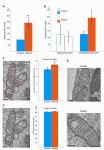Kati
Patient in training
- Messages
- 5,497
For anyone else who has been checking/waiting for the data deposition, it seems to now be available on metabolomicsworkbench.org
Seems to be fewer than the 612 metabolites mentioned
We targeted 612 metabolites in plasma from 63 biochemical pathways by hydrophilic interaction liquid chromatography, electrospray ionization, and tandem mass spectrometry in a single-injection method.
Over 420 metabolites were detectable in all plasma samples
"Area under the receiver operator characteristic curve analysis showed diagnostic accuracies of 94% [95% confidence interval (CI), 84–100%] in males using eight metabolites and 96% (95% CI, 86–100%) in females using 13 metabolites."
Cheney reviewed the naviaux paper. He will hv told them I expectRegarding use of growth hormone. I'm not going to add much to the sum total of knowledge here but the Naviaux study should help in assessing potential treatments. Also, I'd be surprised if the folks at the Open Medicine Foundation (Ron Davis, Naviaux ---) were unaware of the research you refer to re use of growth hormone. Why not drop the folks at the Open Medicine Foundation an email and ask if they are aware of this/this warrants further investigation?
Also, while you've missed the formal period for submitting suggestion to Vicky Whittemore, you should check the responses received (I was notified that the responses were posted online some time ago) to see if anyone else highlighted this research; if they didn't then consider sending an email to Vicky Whittemore re this research.
It may be difficult to measure the level of this hormone directly in blood (i.e. an easily available sample type) but try online (sorry if I have not read/understood above emails). I keep saying this, here in Northern Ireland Government laboratories get £200 ($270) to measure various things in food (including hormones) using mass spectrometry i.e. technique used in Naviaux study (your Government has a similar program re food safety monitoring). These laboratories also use (from distant memory -- and therefore not up to date) various immune assays to measure hormones.
Diagnosing a problem re receptor for growth hormone is interesting; how do they do that? E.g. in diabetes I think they give you glucose and see how long it takes for your blood glucose levels to return to normal. Presumably if you have normal levels of insulin in your blood (chemical messenger) and you give glucose then if the blood glucose levels do not return to normal in the normal time then the insulin receptor is faulty. To check out your growth hormone you'd need to give -- and check the level of ---.
All been done before I'm guessing so look online.
The scientific challenge of assessing how effective growth hormone is, is one thing; getting your Government to put the systems in place is a whole different challenge!
Cheney reviewed the naviaux paper. He will hv told them I expect

Result seems utterly counter-intuitive. Is it a trustworthy and meaningful result?
If true, does it mean that we're using, loosing or just sitting on that extra energy store?
Man, I'd really love to know Naviaux's thoughts on this newly published study!: "Elevated Energy Production in Chronic Fatigue Syndrome Patients" - http://www.jnsci.org/files/html/2016/e221.htm
Yes, elevated... They report finding 250% more ATP in blood mononuclear cells (PBMCs), with all of that coming from synthesis outside of the mitochondria. Also finding normal looking mitochondria, other than a slight (but significant) increase in number and density of their cristae (strongly indicative of raised energy requirement).
View attachment 17801
Result seems utterly counter-intuitive. Is it a trustworthy and meaningful result? Or even expected for someone in the know, like Naviaux? If true, does it mean that we're using, loosing or just sitting on that extra energy store? (Could extracellular ATP signaling, or something related, be draining this additional production, I wondered? Probably nonsensically.)
Discussion already in this thread - http://forums.phoenixrising.me/inde...n-in-chronic-fatigue-syndrome-patients.47443/
Occasionally the counter-intuitive can herald new insights.
The fact that the crista number is increased in CFS patients suggests that their energy demands might be unusually high, which triggers condensation of mitochondrial crista membranes.
Could this mean that rather than ME/CFS suffers being unable to process the available energy fast enough, there may instead be some 'parasitic' mechanism stealing the available energy away from where it is needed, and self regulation mechanisms strive to make up the shortfall, with limited success?
Maybe akin to driving a car with the brakes stuck partly on.
The most obvious thing jumping out at me as that most PWME I know have elevated Cholesterol where this study shows low. That seems surprising.I have to slowly go through it first. That might take days. However I started my journey into ME and CFS biochemistry looking at metabolites, my only "published" piece was about metabolites, and during the 90s there was a lot of metabolic research going on here in Australia, and I talked to a few of those researchers.
I hope to say more soon.
I noticed that too 80 of 84 from CA.Hi @Ben Howell
"Eighty subjects were from California". Can we find out if there is a relationship to where the subjects lived/worked (number of months) and known government reported toxic areas?
Here is a map, that can be used to identify sources of toxic waste. The data is derived from US Gov't sources. If we were able to get a data feed from Terradex and reference it with subject self reports (geographic locations) then we could see if the toxic chemical exposures had any impact on the study participants. If there was a relationship, then we could look at specific chemicals that are detailed about each site.
http://whatsdown.terradex.com/
Maybe Ron is already doing this research? It might be a conflict of interest, since one of the offending sites was formerly occupied by Hewlett Packard (OptoElectronic Division) located in Palo Alto, on Page Mill Road; the land is owned (maybe still is owned?) by Stanford University.
http://www.toxicsites.us/site.php?epa_id=CAD980884209
Thanks!!
GD